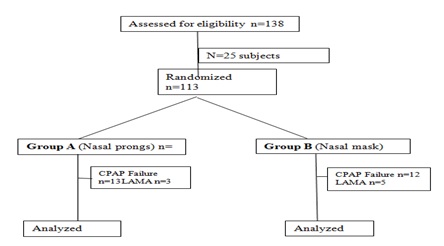A comparative study of incidence and severity of nasal complications while using nasal prongs and nasal mask as CPAP interface in preterm neonates: A Randomized Control trial
Abstract
Objective: To compare the incidence and severity of nasal trauma while using nasal prong and nasal mask as CPAP interface in preterm neonates. Material and
Methods: A comparative study was conducted on preterm neonates (28-34 weeks gestation) with respiratory distress, who were admitted in neonatal unit in a tertiary care level hospital. These babies were randomized and divided into two groups while being put on bubble CPAP, using either nasal prongs (Group A) or nasal mask (Group B) as interface. The data was collected and analyzed for nasal trauma among both groups.
Result: It was observed that there was no significant difference in the overall incidence of nasal trauma in both groups. Mild trauma was more common in babies received nasal CPAP via mask, while severity of trauma increases with use of bi-nasal prongs.
Conclusion: Bubble continuous positive airway pressure with bi-nasal prongs as interface is as effective as nasal mask but causes more severity of nasal trauma.
Downloads
References
2. Polin RA, Sahni R. Newer experience with CPAP. SeminNeonatol. 2002 Oct;7(5):379-89.[pubmed]
3. Silverman WA, Andersen DH. A controlled clinical trial of effects of water mist on obstructive respiratory signs, death rate and necropsy findings among premature infants. Pediatrics. 1956 Jan;17(1):1-10.[pubmed]
4. Schmölzer GM, Kumar M, Pichler G, et al. Non-invasive versus invasive respiratory support in preterm infants at birth: systematic review and meta-analysis. BMJ. 2013 Oct 17;347:f5980. doi: 10.1136/bmj.f5980.[pubmed]
5. Thukral A, Sankar MJ, Chandrasekaran A, Agarwal R, Paul VK (2016) Efficacy and safety of CPAP in low- and middle-income countries. J Perinatol 36:S21–S28
6. Kieran EA, Twomey AR, Molloy EJ, et al. Randomized trial of prongs or mask for nasal continuous positive airway pressure in preterm infants. Pediatrics. 2012 Nov;130(5):e1170-6. doi: 10.1542/peds.2011-3548. Epub 2012 Oct 22.
7. Robertson NJ, McCarthy LS, Hamilton PA, Moss AL. Nasal deformities resulting from flow driver continuous positive airway pressure. Arch Dis Child Fetal Neonatal Ed 1996;75:F209–F212.
8. Singh J, Bhardwar V, Chirla D. To compare the efficacy and complication of nasal prongs & nasal mask CPAP in neonates. UMDS. January 2017;6(1) p 1392-1397.
9. Yong SC, Chen SJ, Boo NY. Incidence of nasal trauma associated with nasal prong versus nasal mask during continuous positive airway pressure treatment in very low birthweight infants: a randomised control study. Arch Dis Child Fetal Neonatal Ed. 2005 Nov;90(6):F480-3. Epub 2005 Jun 7.[pubmed]
10. Chandrasekaran A, Sachdeva A, Sankar MJ, Agarwal R, Deorari AK, Paul VK. Nasal mask versus nasal prongs in the delivery of continuous positive airway pressure in preterm infants - An open label randomized controlled trial. E-PAS. 2014:2936:512.
11. Kumar G, Tiwari A, Shukla A, Chopra M. Study effectiveness of nasal prong and nasal mask in NCPAP in preterm neonates with respiratory distress. JMSCR. May 2017 Vol 05. Issue 05. P 21409-21415.
12. Goel S, Mondkar J, Panchal H, et al. Nasal Mask Versus Nasal Prongs for Delivering Nasal Continuous Positive Airway Pressure in Preterm Infants with Respiratory Distress: A Randomized Controlled Trial. Indian Pediatr. 2015 Dec;52(12):1035-40.[pubmed]
13. Newnam KM, McGrath JM, Salyer J, et al. A comparative effectiveness study of continuous positive airway pressure-related skin breakdown when using different nasal interfaces in the extremely low birth weight neonate. Appl Nurs Res. 2015 Feb;28(1):36-41. doi: 10.1016/j.apnr.2014.05.005. Epub 2014 Jun 5.[pubmed]

Copyright (c) 2019 Author (s). Published by Siddharth Health Research and Social Welfare Society

This work is licensed under a Creative Commons Attribution 4.0 International License.


 OAI - Open Archives Initiative
OAI - Open Archives Initiative


